



Originally published in the Journal of the Oughtred Society, Volume 19 number 2, Fall 2010
with additional information in Volume 25 number 2, Fall 2016, here combined with further calculators added.
In the Fall 2009 issue of the Journal there was an article by Stephan Weiss on non-decimal slide adders¹ in which the Sterling slide adders by Addiator and Addimult were mentioned. In fact there was a variety of different designs of sterling currency slide adder in which the arrangement of the scales on the slides varied as did the carry over method. This article expands on that by Stephan Weiss in the area of Sterling machines. . It is, perhaps, worthwhile reiterating that the pound Sterling (£) in pre-decimal days consisted of twenty shillings (s) which turn were made up of twelve pence (d). The coinage included halfpennies (1/2d) and farthings (1/4d) although the latter ceased to be legal tender after 1960. Decimalisation occurred in 1971 although new five and ten pence pieces were minted and circulated from 1968 onwards being equivalent in value and weight to shilling and two shilling pieces (florins).
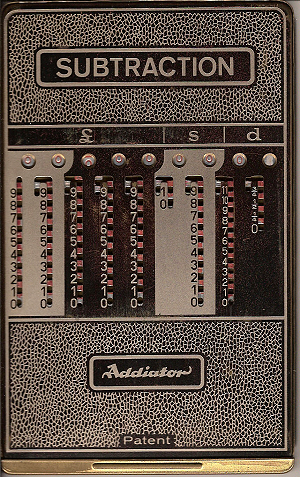
Addiator, addition face
[£ 9-9-9-9-9][s 1-9][d 11-3/4]
[£ 9-
Addiator, subtraction face
Serial number M076362
Serial number M076362
This is similar to the one illustrated in the article by Weiss and shows the layout of the slides applicable to most of the machines he described. It can be seen that the upper face is used for addition and the lower face is used for subtraction. It can also be seen that, from the orientation of the machine when used for subtraction that the slides will be moved in the opposite direction to that for an addition. Whichever way the face slots are arranged this opposite direction for subtraction is fundamental to the operation.
This large (7 x 4.3 inch) Addiator was supplied in leatherette wallet. The pocket for the Addiator was hinged so that both sides could be used. It dates from the 1920s/1930s.
Addimult Addmaster serial numbers 802422 and 437756.
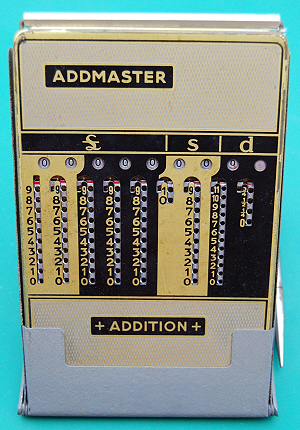
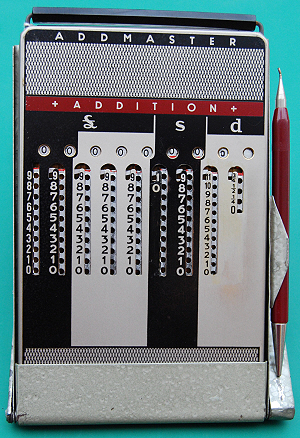
Addimult Addmaster version 1, in its case configured as a desk stand
[£ 9-9-9-9-9][s 1-9][d 11-3/4]
[£ 9-
Addimult Addmaster version 2, in its case configured as a desk stand
[£ 9-9-9-9-9][s 1-9][d 11-3/4]
[£ 9-
These are the Addimult version of the Addiator described above and are the same size, with the same face and slide layout except that the left hand shillings column is full depth although only numbered 0 and 1. However, both were supplied in a steel case that opened up to form a desk stand as shown in the figures. Post WWII. Intriguingly, the one I assume to be later has a lower serial number. Were they really produced in such large numbers?
Addiator Arithma and Kingson Pocket Calculator, Sterling currency versions.


The Addiator Arithma was produced in many variations as a six slide decimal machine and will be familiar to many slide rule collectors as the machine built into the reverse of a range of Faber-Castell slide rules. The Sterling Addiator Arithma is the same size (6.3 x 1.7 inch) as the decimal version and is of brass and steel construction as used on the de-luxe decimal models. Carry over is performed in the same way for both addition and subtraction except that in the latter case the stylus must be carried round the hook at the bottom rather than the top. The Kingson is a Hong-Kong made copy, in aluminium and steel, of the Arithma.
Addiator Arithma
[£ 9-9-9][s 1-9}[d 11]
Kingson Pocket Calculator
[£ 9-9-9][s 1-9}[d 11]
[£ 9-
Kingson Pocket Calculator
[£ 9-
Produx and Original Produx
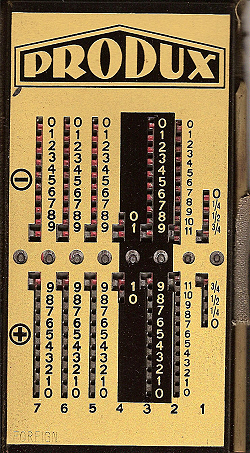
Produx Counting Machine
[£ 9-9-9-9][s 1-9][d 11-3/4]
[£ 9-
Original Produx
[£ 9-9-9-9-9][s 1-9][d 11-3/4]
[£ 9-
The Produx was produced by the firm of Otto Meuter in Germany. This small (4.6 x 2.5 inch) has both addition and subtraction fields on the same side, like the Arithma, but subtraction is placed above addition rather than the other way round. There is no reset bar on this machine; as the slides are moved down they protrude from the bottom edge. It is reset to zero by pushing them back by pushing down against the table surface. It probably dates from the 1930s.
The Original Produx is a post WWII model made by Otto Meuter & Sohn in West Germany. It should be noted that ‘Original’ was placed in front of the name of several German instrument firms at this time, on both sides of the border, and translates as ‘genuine’. It is larger (6.5 x 3.4 inch) than the earlier model and has more slides. It is reset in the usual way by pulling up the bar at the top.
Correntator serial number 006800
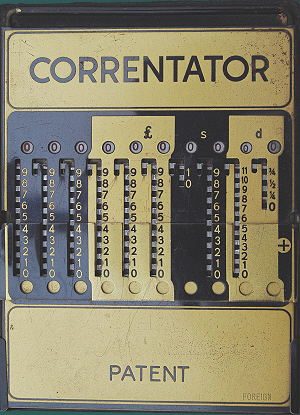
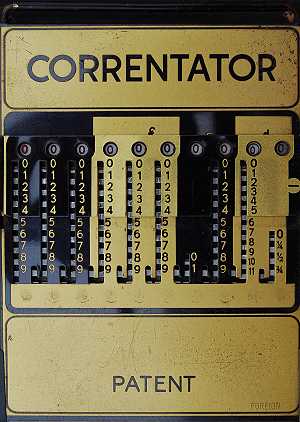
Correntator, flip over panel set for addition
[£ 9-9-9-9-9-9][s 1-9][d 11-3/4]
[£ 9-
Correntator, flip over panel set for subtraction
This is another German machine made, like all the others described so far, in both decimal and Sterling currency versions. It was, if my translation from the German is right, made by Otto Meuter for CBR (Jean Bergmann)². However there is only one field in which numbers can be entered via the sliders. To cope with both addition and subtraction there is a flip over panel, which sets the field for either. It will be noted that there are carry over hooks at both ends of the slots but that only one set is exposed at any time. In this way the Correntator can be used for both addition and subtraction just as if it had two separate input fields, as described in the article by Weiss, except that when subtracting red is just pushed up and white is pushed down and carried round the hook. The calculator is housed in a leathercloth wallet.
The Exactus Mini-Add
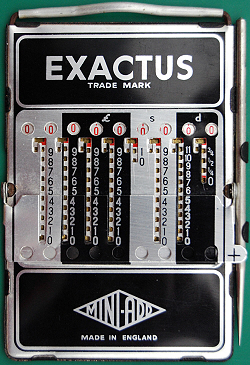
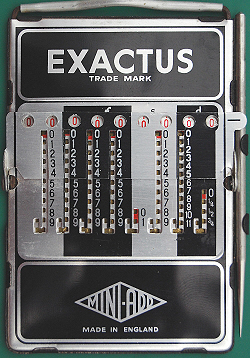
Exactus Mini-Add, flip over panel set for addition
[£ 9-9-9-9-9][s 1-9][d 11-3/4]
Exactus Mini-Add, flip over panel set for subtraction
After WWII a smaller, decimal version of the Correntator was made by Unical in Switzerland. The Exactus Mini-Add is the Sterling version of this, made in England, and is 4.5 x 3 inches. The address of Exactus was 1a Creed Lane, St Paul’s, London EC4.
The Pocket Adding Machine
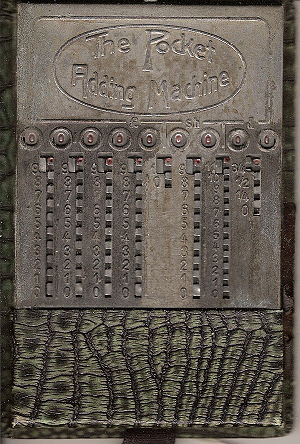
Oh! On first sight it looks as though this machine can only be used for addition since it has only one input field and there are only carry over hooks at the top of the columns. But, this is not so. It can be used for subtraction as well provided that the right rules are followed. Once again the rules for addition are silver down, red up and around the hook. If the stylus won’t go round the hook, then the stylus must be inserted in the next slide to the left adjacent to the number 1 and pushed right up and round the hook.
With this machine shillings do not automatically convert to pounds and it is necessary, once the number of shillings reaches 20 or more, to put the stylus in at the bottom of the left hand shillings slot at push it up and round the hook one or more times until the number is less than 20. This is also the case for the Correntator, Exactus and Produx machines.
For subtraction the rules are as follows: If the number to be subtracted is equal to, or smaller than the number appearing in the result window for that column the stylus is inserted next to the 0 and pushed up to the number to be subtracted. If the number to be subtracted is larger the stylus is inserted in the bottom of the hook and brought back round and down until the number to be subtracted is reached. If the stylus locks and can’t be brought back round the hook it has to be inserted at the top of the column
Pocket Adding Machine
[£ 9-9-9-9-9][s 1-9][d 11-3/4]
[£ 9-
and brought down to the number and then inserted in the hook of the next column to the left and brought round and down to the number 1.
The Pocket Adding Machine is the Sterling equivalent of the Pro Calculo decimal slide adder and, like its sibling, has a mock crocodile skin case. It is believed to have been made by Otto Meuter. In the USA, the Ve-Po-Ad, made by the Reliable Typewriter & Adding Machine Co of Chicago, was a copy of the Pro Calculo.
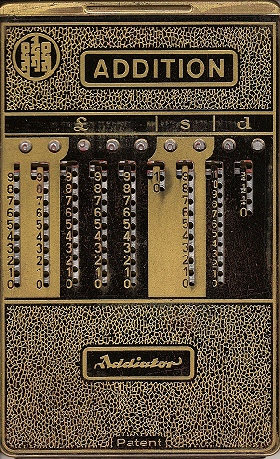
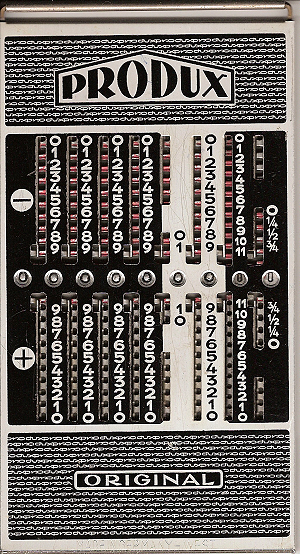

Addometer, Sterling Currency Model
[£ 9-9-9-9][s 1-9][d 11-3/4]
[£ 9-
The Reliable Typewriter & Adding Machine Co also made a dial adder called the Addometer that, in standard form, was a decimal machine. However they also made a version for feet and inches and eighths, and a Sterling currency version. I hope that I will be excused for showing a picture of the latter. The dial adder was much more user friendly. Just rotate clockwise to add and anti-
The Sterling version was housed in a robust, leathercloth covered, wood case with a snap fastening lid. It was supplied by Taylor’s. 74 Chancery Lane, London.
References
[1] Weiss, Stephan. Non-decimal Slide Adders and the Carry, Journal of the Oughtred Society 18:2, p. 22-25, Fall 2009.
[2] Girbardt, W., EMA Rechenbretter website, Correntator A.B.C.
http://www.uni-griefswald.de/~wwwmathe/RTS/rh002.html , (last visit 02/12/2006).
[3] Atzbach, R., Additionsgeräte für Zoll und Zeit.
http://www.rechenwerkzeug.de/Zolladd.htm, (last visit 26/02/2010).
[1] Weiss, Stephan. Non-
[2] Girbardt, W., EMA Rechenbretter website, Correntator A.B.C.
http://www.uni-
[3] Atzbach, R., Additionsgeräte für Zoll und Zeit.
http://www.rechenwerkzeug.de/Zolladd.htm, (last visit 26/02/2010).
Sterling Currency Addometer
Addimult Addmaster Junior [£9-9-9-9][s1-9][d11-3/4]
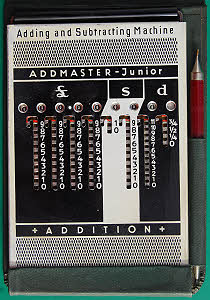
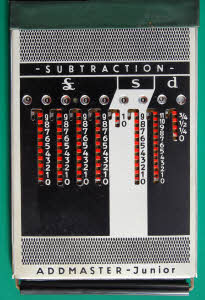
Earlier I described and illustrated two versions of the Addimult Addmaster. Whilst clearly portable and capable of being carried in a suitably large pocket they were essentially desk machines as the metal carrying case could be folded to form a desk stand. The Junior is more compact, measuring five inches by 3.5, and came mounted in a wallet case so it was clearly intended to be carried in the pocket. This particular example still has its stylus cum propelling pencil, notepad, original retail box, instructions, and guarantee dated 21/7/1959.
Addimult Addmaster Baby [£9-9-9][s1-9][d11]
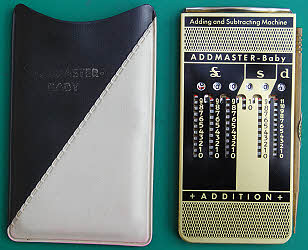
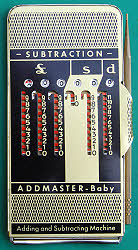
The Addmaster Baby was the smallest of the three Addmaster machines being 5 x 2.5 inches with one less £ column than the Junior and no column for halfpennies or farthings. It was housed in a black & grey, flexible PVC case. It had a simple metal stylus.
Produx Record [£9-9-9-9-9-9][s1-9][d11-3/4]
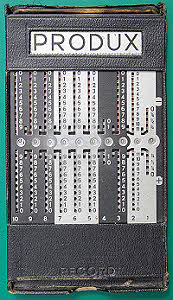
This is a massive machine, eight inches by 4.5, mounted in a wallet case, part of which, along with the stylus is missing from my example. It was a complete surprise to find that Lucie Meuter in the DDR had manufactured a Sterling machine. Not only is it larger than the Original Produx machines made by Otto Meuter in Western Germany but can add up to one digit more, matching the capability of the large size Correntator.
Addiator Duplex [£9-9-9-9][s1-9][d11-3/4]
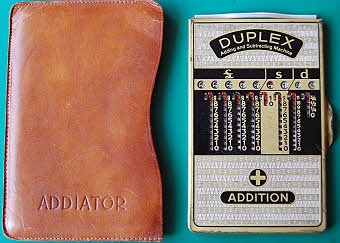
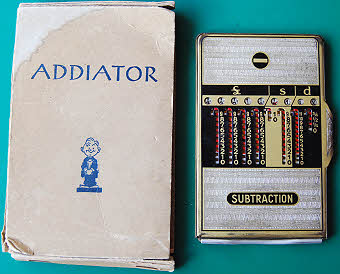
This is the middle size Addiator, between the full size version listed at the start of this paper and the Arithma and is quite a late example judging by the type of case. although it still caters for farthings that ceased to be legal tender in 1960.
British Calculator (Model B) and BriCal, [£4-9-9][s19][d11½]
This British Calculator (Model B) was made by T J Marshall & Co, probably ca. 1905. Serial no 1185 it has faux Morocco covered case lined with blue velvet. The design was patented by H M Dickinson and made from 1900 to 1909. It was also sometimes labelled “BRICAL” where this example is labelled ‘Model B’. It is 5.3 inches in diameter and reads £.s.d in halfpennies up to £499.19s.11½d. Because the £ scale only goes up to 49 there is a subsidiary window to the left that reads in steps of 50 from 0 to 450 that has to be added to the £ figure. It has automatic carry over on all the scales.
British Calculator (Model B) and BriCal, [£4-
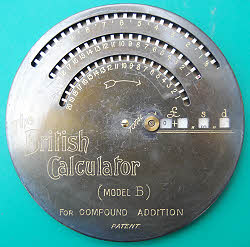
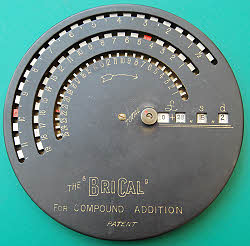
The Brical shown above is another version. Quite why it is constructed differently is not known, neither do I know which type came first since, as noted above, the Model B type also comes labelled BriCal
Addiator Fractomator [ft.9-9-9-9-9-9-9][in.11][sixteenths 15]
I know it’s not Sterling but I mentioned in my original article that I had seen one of these on the Internet. Since then I have added one to my collection. It is the same size as the original Addiator but, as you will see, has a negative capability as well as having one more feet column than the Sizematic. Mine is missing its stylus and case.
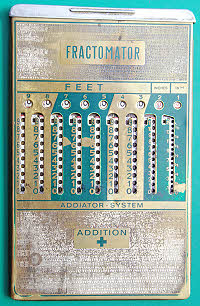
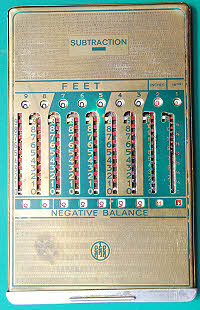
| Early Sets |
| Traditional Sets |
| Later Sets |
| Major Makers |
| Instruments |
| Miscellanea |
| W F Stanley |
| A G Thornton |
| W H Harling |
| Elliott Bros |
| J Halden |
| Riefler |
| E O Richter |
| Kern, Aarau |
| Keuffel & Esser |
| Compasses |
| Pocket compasses |
| Beam compasses |
| Dividers |
| Proportional dividers |
| Pens |
| Pencils |
| Rules |
| Protractors |
| Squares |
| Parallels |
| Pantographs |
| Sectors |
| Planimeters |
| Map Measurers |
| Miscellaneous |
| Materials Used |
| Who made them |
| Who made these |
| Addiator |
| Addimult |
| Other German |
| USA |
| Miscellaneous |
| Microscopes |
| Barometers |
| Hydrometers & Scales |
| Pedometers |
| Surveying Instruments |
| Other instruments |
| Workshop Measuring Tools |
| Catalogues & Brochures |
| Micrometers & Verniers |
| Engineering rules and gauges |
| Wood rules & calipers |
| Dial gauges & miscellaneous |